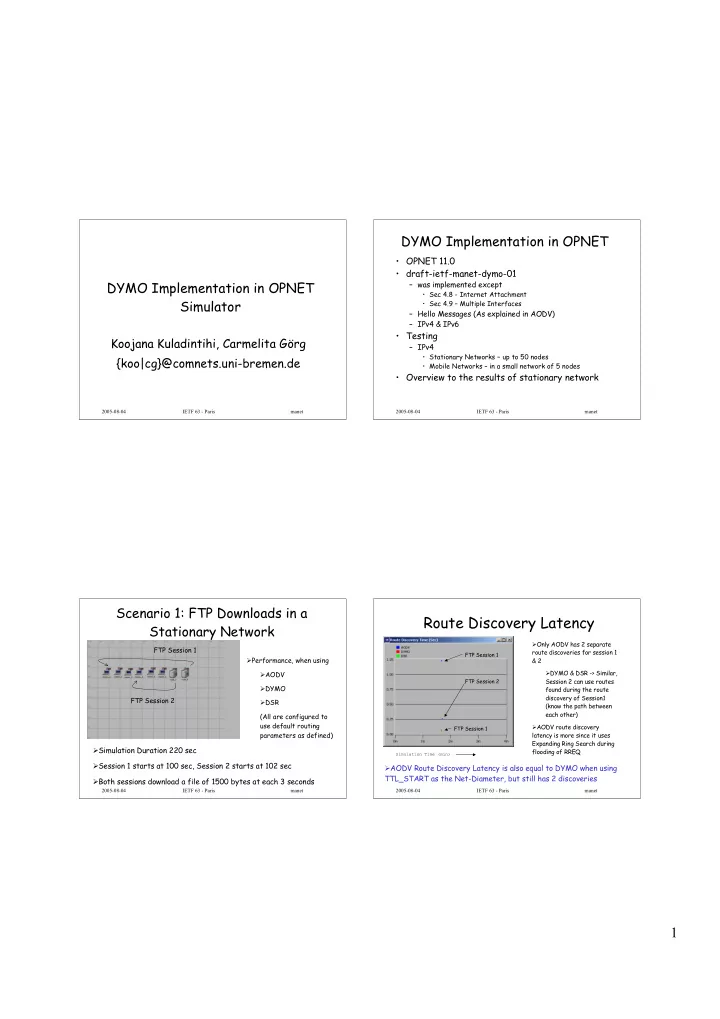

DYMO Implementation in OPNET • OPNET 11.0 • draft-ietf-manet-dymo-01 DYMO Implementation in OPNET – was implemented except • Sec 4.8 - Internet Attachment Simulator • Sec 4.9 – Multiple Interfaces – Hello Messages (As explained in AODV) – IPv4 & IPv6 • Testing Koojana Kuladintihi, Carmelita Görg – IPv4 • Stationary Networks – up to 50 nodes {koo|cg}@comnets.uni-bremen.de • Mobile Networks – in a small network of 5 nodes • Overview to the results of stationary network 2005-08-04 IETF 63 - Paris manet 2005-08-04 IETF 63 - Paris manet Scenario 1: FTP Downloads in a Route Discovery Latency Stationary Network Only AODV has 2 separate FTP Session 1 route discoveries for session 1 FTP Session 1 Performance, when using & 2 DYMO & DSR -> Similar, AODV FTP Session 2 Session 2 can use routes DYMO found during the route discovery of Session1 FTP Session 2 DSR (know the path between each other) (All are configured to use default routing AODV route discovery FTP Session 1 parameters as defined) latency is more since it uses Expanding Ring Search during Simulation Duration 220 sec flooding of RREQ Simulation Time (min) Session 1 starts at 100 sec, Session 2 starts at 102 sec AODV Route Discovery Latency is also equal to DYMO when using TTL_START as the Net-Diameter, but still has 2 discoveries Both sessions download a file of 1500 bytes at each 3 seconds 2005-08-04 IETF 63 - Paris manet 2005-08-04 IETF 63 - Paris manet 1
FTP Download Response Time (Sec) Total Load in bps (Link Layer) At the beginning AODV has higher Response time After the routes are made, DSR has higher response time than AODV & DYMO (due to source routing) In general, DYMO has the Simulation Time (min) lowest response time AODV & DYMO have Routing overhead at the beginning (Hello Messages Simulation Time (min) are not used in this scenario)- Dymo routing overhead is higher than AODV DSR has the overhead even after the routes are made 2005-08-04 IETF 63 - Paris manet 2005-08-04 IETF 63 - Paris manet Scenario 2: 50-node Stationary Route Discovery (Sec) & Num. of Network RREQ packets sent Simulation Duration 300 sec Each node starts downloading files (@6 sec) from the server in the middle FTP Download Starts at each node between (100-300) in an uniformly distributed Simulation Time (min) manner Number of Route Discoveries (AODV > DYMO > DSR) AODV flooding is controlled by ERS Lasts abt 40 sec Each DYMO flooding is up to 10 hops, but no route discoveries if the paths are known 2005-08-04 IETF 63 - Paris manet 2005-08-04 IETF 63 - Paris manet 2
Routing Traffic Sent Delay in WLAN Simulation Time (min) DYMO has sent more routing traffic (due to path accumulation) Higher route discoveries than DSR and message sizes are bigger since REBlock attachments Simulation Time (min) Flooding in AODV uses ERS. Total RREQ message propagation is controlled 2005-08-04 IETF 63 - Paris manet 2005-08-04 IETF 63 - Paris manet Observations Observations • Path Accumulation in DYMO (Attachment of • Flooding to Net-Diameter (TTL=10) ReBlocks ) in DYMO – Improve the performance by reducing the route discoveries when intermediate nodes want to send data (Scenario 1) – Performance is better in smaller – This performance is no longer valid, if intermediate networks (Scenario1) nodes start the route discoveries after the lifetime of the route discovery, i.e 3 sec (Scenario 2) – For larger networks, this will increase – Solution? more routing traffic overhead. • Send a separate RE message to extend the path lifetime (Scenario 3) (10 sec, 100Sec, ?) after the successful route discovery or Lifetime of routes during the route discovery could be increased – Solution? • Adapting a mechanism like ERS 2005-08-04 IETF 63 - Paris manet 2005-08-04 IETF 63 - Paris manet 3
Recommend
More recommend